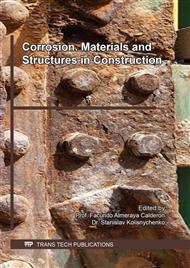p.65
p.71
p.76
p.82
p.88
p.95
p.101
p.107
p.113
Experimental Study on Corrosion Behaviour of Concrete Containing Bottom Ash as Partial Replacement of Fine Aggregate
Abstract:
Concrete is a material synonymous with strength and longevity and plays a vital role in the construction activity. Scarcity of natural sand and its fast rising cost have paved way for use of bottom ash, a residue being collected from the thermal power stations, as substitute for sand. Recent research shows that the mechanical properties of concrete containing bottom ash as a partial replacement of fine aggregate is suitable for construction. The various parameters involved are different percentage of bottom ash and grades of concrete. This present experimental study is made on chloride induced corrosion using accelerated corrosion test (ACT) and related durability properties such as water absorption & porosity, water sorptivity and rapid chloride penetration test (RCPT). Compressive strength test is performed in order to ascertain the mechanical property of bottom ash concrete. The above tests were conducted on the concrete specimens and the results were found comparable with the control concrete up to 20% replacement of bottom ash. Utilization of bottom ash in concrete becomes more significant in cost-saving and reducing the quantity of landfill, thus providing an economical and ecological way of conservation of natural resources.
Info:
Periodical:
Pages:
88-94
Citation:
Online since:
November 2016
Authors:
Keywords:
Price:
Сopyright:
© 2017 Trans Tech Publications Ltd. All Rights Reserved
Share:
Citation:



